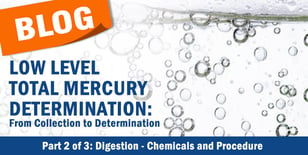 In Part 1 of this series, sample collection, container types, and preservation techniques for low-level total mercury (Hg) analysis were discussed. In Part 2, I will highlight contamination sources from chemicals and the potential for analyte loss associated with digestion protocols.
In Part 1 of this series, sample collection, container types, and preservation techniques for low-level total mercury (Hg) analysis were discussed. In Part 2, I will highlight contamination sources from chemicals and the potential for analyte loss associated with digestion protocols.
The exact digestion protocols are dependent on the regulatory method and the sample type, but all follow the same general steps:
- Preserve/Acidify
- Oxidize
- Wait time/Temperature
- Reduce excess oxidizer
- Minimum/Maximum reaction time
- Reduce Hg+2 to Hg0
- Gas transports Hg0 through instrument for elemental analysis
Regular grades of chemicals can be sparged with high-purity inert gas (like argon fitted with an in-line gold trap) to remove contaminates by bubbling through the solution. Sparging can benefit:
- Reagent water
- 3% hydrochloric acid (or another simple acidic matrix used as diluent)
- Hydroxylamine chloride solution
- Stannous chloride solution
Reagent blanks and method blanks are an important quality control tool. Reagent blanks should be analyzed every time a new batch of oxidizer and reducing agent are made. If your reagents are not clean enough, you may need to sparge them or find a new source to purchase.
Method blanks reveal the state of the entire process. This type of blank is prepared and analyzed using the containers, labware, reagents, and protocol identical to sample analysis. This demonstrates the system and process is not contaminated and will not jeopardize sample results. Method blanks also give insight into the cleanliness of your equipment, such as glassware and digest tubes.
I strongly recommend having dedicated glassware for each reagent and standard needed. This reduces your chance of cross-contamination. There are also certified clean storage bottles and digest tubes available.
While blanks give us insight into contributions of mercury from chemicals and equipment, let us discuss digestion steps where mercury loss is possible.
There are a few stages in the digestion protocol where mercury can be lost from the sample. When preserving the sample with acid or oxidizer, the sample container needs to be made of approved materials. Borosilicate glass or fluoropolymer bottles are recommended by USEPA method 1631, and polyethylene bottles are prohibited. Mercury is known to travel through the crosslinks of certain polymers, which can lead to mercury loss.
Another phase where mercury can be lost is during the oxidation process, especially if a heated block digestor is used. When heating samples, the caps need to be loosened enough so pressure does not build inside, but not so much that the reflux can escape through the threads of the cap. Another common place to lose mercury is during the reduction of excess oxidizer. Hydroxylamine hydrochloride not only will reduce the potassium permanganate or bromine monochloride —a portion of Hg2+ will also fall victim. Thus, you run the risk of losing Hg0.
The cold vapor atomic absorption (CVAA) methods do not give any specific hold times that are acceptable to avoid Hg loss, but the majority state to run immediately after the addition of hydroxylamine to avoid loss of elemental Hg. For purge and trap systems, like CVAA or cold vapor atomic fluorescence (CVAF) systems that use gold trap amalgamation techniques, my recommendation is to reduce and run immediately. For continuous flow systems, it is best to reduce and wait for 30 minutes to off-gas the nitrogen and other reaction gases to avoid signal interference.
Once we ensure Hg contamination is low and analyte loss is minimal, it is time to analyze our water samples. In my next blog, I will review the different types of instrumentation used for low-level mercury determination offered by Teledyne Leeman.
Please follow this series as we cover a range of tips and tools that can help you.
- Part one is linked here, Low Level Total Mercury Determination: From Collection to Determination
For more information on Leeman Labs Mercury Analyzers or if you would like to someone to contact you - click the button below.

